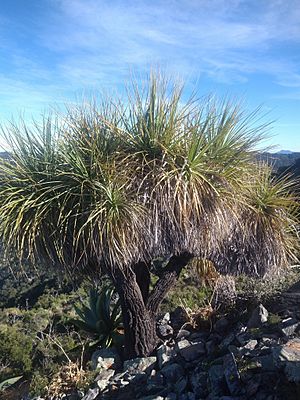Nolina beldingii facts for kids
Quick facts for kids Nolina beldingii |
|
|---|---|
 |
|
| Conservation status | |
| Scientific classification | |
| Genus: |
Nolina
|
| Species: |
beldingii
|
| Synonyms | |
|
|
Nolina beldingii is a type of plant that lives for many years. It is a flowering plant in the Asparagaceae family. People often call it the Cape nolina or Belding's beargrass.
This plant looks like a small tree. It can grow up to 7 meters (about 23 feet) tall. Its trunk has cracked bark, and at the top, it has many leaf rosettes. The leaves are long and narrow, up to 1.15 meters (about 3.8 feet) long. Local people use these leaves for thatching roofs.
Nolina beldingii is found only in one place: Baja California Sur in Mexico. It grows in the highest parts of the Sierra de la Laguna mountains. You can mostly find it in oak forests above 1,000 meters (about 3,280 feet) high. It likes rocky areas made of granite.
Contents
What Nolina beldingii Looks Like
This plant is a type of Nolina that grows like a tree. It can reach 5 to 7 meters (16 to 23 feet) tall. Its trunk can be about 50 centimeters (20 inches) wide. The bark is cracked and forms rectangular blocks. These blocks are 10 to 25 centimeters (4 to 10 inches) long. The bark is gray, but it turns a reddish-brown color as it gets older.
At the top of the trunk, there are 1 to 26 groups of leaves called rosettes. Each rosette can be 1 to 3 meters (3 to 10 feet) wide. Old leaves stay on the trunks below the rosettes. The leaves are long and thin, like lines. They are 0.75 to 1.15 meters (2.5 to 3.8 feet) long. They are also 1.4 to 2.0 centimeters (0.5 to 0.8 inches) wide in the middle. The leaves are dark green and feel smooth. Sometimes, they turn reddish towards the back. The very tip of the leaf is smooth. However, the edges of the rest of the leaf have small teeth, about 0.2 millimeters long.
The plant's flowers grow in a large cluster called an inflorescence. This cluster is 2 to 3 meters (6.5 to 10 feet) long and 20 to 70 centimeters (8 to 28 inches) wide. The main stalk of the flower cluster is about 1 meter (3.3 feet) tall. It is smooth and has linear-shaped bracts (small leaf-like parts). The branches of the flower cluster are loose and open. They can be curved or wavy and are up to 23 centimeters (9 inches) long. Branches closer to the top are about 15 centimeters (6 inches) long.
The male flowers are bell-shaped and 4 to 6 millimeters (0.16 to 0.24 inches) wide. They sit on small stalks called pedicels, which are 2.5 to 3 millimeters (0.1 to 0.12 inches) long. The female flowers are also bell-shaped. Their pedicels are 4 to 8 millimeters (0.16 to 0.3 inches) long. These flowers are light yellow to cream-colored. They have a reddish line down the middle. The fruits of the plant are 1.4 to 1.5 centimeters (0.55 to 0.6 inches) wide.
How Nolina beldingii Was Discovered
A naturalist named Lyman Belding first found this plant for Western scientists. Belding went on several trips to the Sierra de la Laguna to study birds. Townshend Stith Brandegee wrote the first scientific description of the plant in 1890. He named it Nolina beldingi after Belding, who had told him where to find it.
Brandegee wrote that a local type of wasp often built nests in the plant. This made it hard for him to collect fruit from a plant growing on a dangerous cliff. He also said that this plant looked similar to the Dracaena plants grown for decoration in San Francisco. Brandegee did not mention a specific plant sample (called a type specimen) when he described the species. So, a sample collected in 1893 is now used as the main reference specimen.
Where Nolina beldingii Lives
This plant is found only in the Sierra de la Laguna mountains. This mountain range is in the Cape region of Baja California Sur, Mexico. It grows on rocky areas made of granite. You can find it at elevations from 1,000 meters (3,280 feet) to 1,800 meters (5,900 feet) high. It often grows in the highest parts of the mountains.
Nolina beldingii is mostly found on the steep slopes and cliffs. It lives in the local oak and pine forests. It often grows near other trees like Quercus tuberculata, Q. devia, Q. arizonica, and Arbutus peninsularis. It also grows with the rare plant Dudleya rigida. Brandegee said that this plant was "the most striking part of the vegetation" among the oaks and pines.
How People Use Nolina beldingii
People who live in the area use the leaves from this plant. They use them for thatching roofs on their homes. Other types of Nolina plants are also used by local people. They make things like mats, baskets, and hats from the leaves. In some parts of Arizona, New Mexico, Sonora, and Chihuahua, people use Nolina leaves to make brooms.
See also
 In Spanish: Nolina beldingii para niños
In Spanish: Nolina beldingii para niños



